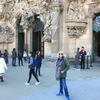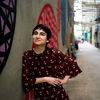

- Bring your own drinks
- Alcoholic and non-alcoholic drinks provided
-
Wheelchair access
- Wheelchair Accessible
-
- Kid-friendly event
This is a groupmuse
A live concert in a living room, backyard, or another intimate space. They're casual and friendly, hosted by community members.
Host
Hi there! Please join me as I host my last Groupmuse in NYC before I move to another city and try to build up a Groupmuse-like community there. For this special occasion I'm excited to welcome pianist Cade Roberts who will perform a program of suites by Grieg and Kruusmaa and Schubert's Sonata in B-flat major which is one of my absolute favorites of the solo piano repertoire. Cade has performed all over Europe and the US and recently earned his masters degree in piano from the Manhattan School of Music. You can find out more about Cade at caderoberts.com.
Guest arrival begins at 7:30pm with music to begin around 8pm. I'll provide light snacks, non-alcoholic drinks, some wine, and maybe we'll have a cake too. Feel free to BYOB. Please note I'd like us to take off our shoes upon entering the apartment.
What's the music?
ALISSON KRUUSMAA
Suite for solo piano
EDVARD GRIEG
Holberg Suite
FRANZ SCHUBERT
Piano Sonata in B-flat major, D. 960
Where does this music come from?
ALISSON KRUUSMAA (1992 - )
Winner of the 2021 Endowment for Music of the Cultural Endowment of Estonia, Alisson Kruusmaa has emerged as one of the most exciting and commissioned young Estonian composers today. She has collaborated with numerous ensembles including the Dutch National Opera and Ballet, Estonian Philharmonic Chamber Choir, Estonian National Symphony Orchestra, Tallinn Chamber Orchestra, Orkest de Ereprijs, Kaleidoscope Chamber Orchestra, Phion Orchestra of Gelderland and Oveijssl, Le Cameriste Ambrosiane, Pelargos Quartet, Eclipse Quartet, and Rookh Quartet. In recent years, her music has appeared at several festivals including the Gaudeamus Muziekweek (Netherlands), Andriessen Festival (Netherlands), Cello Fest (Finland), Mise-En Festival (USA), and the Kaleidoscope Chamber Orchestra Festival (USA). Alisson Kruusmaa’s Suite for solo piano (2013) is a four movement piece inspired by the Baroque dance suite. The Prelude, Allemande, Sarabande and Gigue take subtle hints from the suite form while creating room for new, ethereal reflections. Similar to Johann Sebastian Bach’s Goldberg Variations - one the greatest baroque keyboard masterpieces - the suite concludes with the repetition of the first movement creating a coherent symmetry from start to finish. The world premiere was performed by Johan Randvere on April 4, 2013 in Tallinn, Estonia followed by the US premiere on April 21, 2024 in New York City by Cade Roberts.
EDVARD GRIEG (1843-1907)
The year 1884 marked the 200th anniversary of the birth of Norwegian writer Ludvig Holberg and to commemorate Holberg’s contributions to Norwegian culture, Holberg’s hometown, Bergen, planned a grand celebration commissioning a new cantata for male voices from Edvard Grieg to be performed outdoors next to a new monument to the playwright. Later that year Grieg also composed another work in honor of Holberg: In Holberg’s Time: Suite in Olden Style; a suite of five French Baroque-style dances for solo piano. One year after completing the Holberg Suite, Grieg created a version for string orchestra which has become one of Grieg’s most popular and beloved works today, however, the piano version is performed seldom in concert. The composer, however, considered both versions of the Holberg Suite to be of equal merit and adapted the music “most idiomatically for both forces.” The opening Prelude creates a feeling of excited anticipation with perpetual arpeggiated figures accompanied by long floating melodies. The Sarabande follows — a slow, reflective interlude. A sparkling Gavotte and its contrasting musette feature a low sounding drone in imitating musical styles found in Norwegian folk music. The melancholic Air is the only movement in a minor key, acting as the emotionally profound center of the suite. The closing Rigaudon evokes the rowdy and playful folk sonorities of the Norwegian Hardanger fiddle - Norway’s national instrument. While Grieg’s Holberg Suite in its orchestral adaptation rightfully earned its high celebration, the original piano version stands as a remarkable gem in its own right, meriting more frequent performances and greater recognition for its ability to enchant audiences with the intimate and nuanced interpretation offered by the piano.
FRANZ SCHUBERT (1797-1828)
Schubert’s Piano Sonata in B-flat major, D. 960, stands as one of the composer’s final and most profound works, completed shortly before his death in 1828. It exemplifies the tradition of Classical form and style while introducing Romantic sensibilities of the early 19th century, marked by harmonic richness and emotional depth. Written during a period of personal turmoil and declining health, the sonata reflects Schubert’s contemplation on mortality and existential themes, making it a poignant testament to his artistic maturity and output. The first movement, marked Molto moderato, opens with a serene and expansive theme which he develops through the entirety of the movement, weaving through a tapestry of contrasting moods, from introspective reflection to passionate outbursts, all within the framework of lyrical beauty and harmonic exploration. The second movement, Andante sostenuto, unfolds as a deeply expressive and melancholic theme, characterized by its tender lyricism and seamless harmonic shifts. Schubert’s gift for writing melodies shines through in this movement, evoking a sense of profound introspection and emotional depth. The contrasting middle section in A major offers a ray of hope amidst the initial melancholy of the opening C-sharp minor, with its bright atmosphere and gently flowing lines, suggesting a fleeting moment of solace before the return to the poignant introspection of the opening theme. The third movement, Allegro Scherzo (Allegro vivace con delicatezza), provides contrast to the previous two movements with its playful and dance-like character. Within the main lively framework of the movement, the trio section offers a more serious theme, where mischievous interruptions in the bass register create an unsettling yet humorous character. The final movement, Allegro ma non troppo,
concludes the sonata with a sense of resolution and transcendence. It begins with a lively theme that alternates between moments of jubilance and introspection, leading to a climatic conclusion that reaffirms the sonata’s overarching themes of life’s struggles and ultimately serenity.
Location
Exact address sent to approved attendees via email.
This is a groupmuse
A live concert in a living room, backyard, or another intimate space. They're casual and friendly, hosted by community members.
Host
Attendees




















 Continue with Facebook
Continue with Facebook
 Continue with Google
Continue with Google
 Continue with Apple
Continue with Apple
Comments
Comment sections are only for participants.